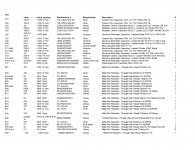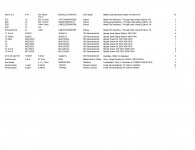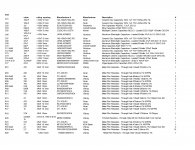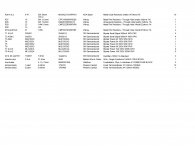Hi Guys,
I know I'm late to the party but I just got my boards and I know there have been componant changes since this all started. My boards show values rather than part numbers. Did anyone make a silkscreen shot showing part numbers so I don't have to try and figure them out from the schematic?
Thanks, Terry
I know I'm late to the party but I just got my boards and I know there have been componant changes since this all started. My boards show values rather than part numbers. Did anyone make a silkscreen shot showing part numbers so I don't have to try and figure them out from the schematic?
Thanks, Terry
Another question. I am presently trying to update Byron's BOM. He shows an R30 at 10R, I can't find that resistor on any of the schematics I've been able to able to dig up. Also, Carlos shows replacing D1 and D3 with 47R resistors. What is the watt rating for these?
Thanks, Terry
Thanks, Terry
Under normal circunstances the dissipation there is 67 miliwatts
So, you can use 1/4 watt resistor.
It will behave alike a fusistor....if current increase too much due to component failure, then it will burn and will open the circuit the same way a fuse does.
Install it with clearance in relation the pcboard surface... 2 milimeters is enougth
regards,
Carlos
So, you can use 1/4 watt resistor.
It will behave alike a fusistor....if current increase too much due to component failure, then it will burn and will open the circuit the same way a fuse does.
Install it with clearance in relation the pcboard surface... 2 milimeters is enougth
regards,
Carlos
OK, I updated Byron's BOM with what I think are the latest updates. Someone who knows, please check it for accuracy. I have it saved in excel so I can make changes fairly quickly.
Attachments
Here's my inital comments:
C03 is the input capacitor; 1uF is a suitable value and it should be a high quality film type. Polystyrene would be ideal however it won't fit on the board; Polypropylene will. I have selected Panasonic part ECW-FD2W105J for this component.
C04: I would like to see a quality Mica cap in this position. For example, Cornell Dubier part no. CD15FD221JO3F.
C08: 63V electro is inadequate unless rail voltage is < 56V. If 64V rails then 80-100V cap.
R09: this value along with R11 determines the amount of amplifier gain. 820R gives a gain of 58.3. I think that for high level sources or when driven by a preamp the gain should be reduced further. If you increase R09 to 1.5K then the gain drops to 32x.
If you reduce the open loop gain from 58x to 32x you might need to increase the Cdom (C10) to a higher value to maintain stability. Perhaps 100-180pF to be on the safe side.
C03 is the input capacitor; 1uF is a suitable value and it should be a high quality film type. Polystyrene would be ideal however it won't fit on the board; Polypropylene will. I have selected Panasonic part ECW-FD2W105J for this component.
C04: I would like to see a quality Mica cap in this position. For example, Cornell Dubier part no. CD15FD221JO3F.
C08: 63V electro is inadequate unless rail voltage is < 56V. If 64V rails then 80-100V cap.
R09: this value along with R11 determines the amount of amplifier gain. 820R gives a gain of 58.3. I think that for high level sources or when driven by a preamp the gain should be reduced further. If you increase R09 to 1.5K then the gain drops to 32x.
If you reduce the open loop gain from 58x to 32x you might need to increase the Cdom (C10) to a higher value to maintain stability. Perhaps 100-180pF to be on the safe side.
Hi Ranchu,
Thanks for looking over the BOM. I have changed C03, 04 & 08. I didn't notice that 08 wasn't 100V. When making up my order from Mouser, I had replaced it with UPW2A470MPD6. I just forgot to change it in the BOM.
R09 @ 820R is taken directly for Carlos' schematic in post #1764. I don't think Carlos likes using a preamp with his amps, just a pot. I will be using a B1 buffer which has no gain so I will probably try it as is.
I actually tried to include all of the changes shown in that schematic.
I am using MJL4281/4302 output transistors as I already have them. I left the BOM as is for the same reason you noted.
Also, for C03 I actually ordered MKP4-1/250/10P22. I'm not sure if it i any better or worse.
I am attaching the corrected BOM. If you or anyone else sees something else that needs to be changed please let me know.
Thanks, Terry
Thanks for looking over the BOM. I have changed C03, 04 & 08. I didn't notice that 08 wasn't 100V. When making up my order from Mouser, I had replaced it with UPW2A470MPD6. I just forgot to change it in the BOM.
R09 @ 820R is taken directly for Carlos' schematic in post #1764. I don't think Carlos likes using a preamp with his amps, just a pot. I will be using a B1 buffer which has no gain so I will probably try it as is.
I actually tried to include all of the changes shown in that schematic.
I am using MJL4281/4302 output transistors as I already have them. I left the BOM as is for the same reason you noted.
Also, for C03 I actually ordered MKP4-1/250/10P22. I'm not sure if it i any better or worse.
I am attaching the corrected BOM. If you or anyone else sees something else that needs to be changed please let me know.
Thanks, Terry
Attachments
Last edited:
WIMA MKP is another excellent choice for the input cap.
I'm building mine with a simple pot as volume control - as Carlos intended. I read somewhere that the DX amps have really high input impedance (47K?) which might explain why they couple well with a passive attenuator. I have a B1 that I'll also test as comparison.
I'm building mine with a simple pot as volume control - as Carlos intended. I read somewhere that the DX amps have really high input impedance (47K?) which might explain why they couple well with a passive attenuator. I have a B1 that I'll also test as comparison.
I am glad forgiven is reading with attention
Thank you still4given.
I use to say, despite people does not give attention because the interconnecting holes a lot of us have that connects one ear to the other and exaust all the stuff in the atmosphere without the needed brain processing and understanding.
My amplifiers can be just a little bit better than others because of current choice, part's selection, topology and in special the tuning made by ears...i do not give a sheet (paper) for calculation results..i just calculate to avoid to make big mistakes..but what i use to make is to tweak and listen... a hard work of try an error... an entire day tweaking and burning my finger tips..comparing one standard channel with another one beeing tweaked....i use to have "performance".... sonics..this is the focus.... as an accident i am having low distortion too...but this may tbe consequence of tweaking.... i am not creating in the simulator or into a sheet of paper and them testing in the real world.... i do the opposite.... i do real world (sometimes parts get damaged as a result of that).
My amplifier beat easy all others....very easy..... laughing...rolling into the floor ...when people say that gonna compare i use to laugh and say.
A new looser!
No way to beat the philosophy...the reduction of stages...the reduction of parts into the audio patch, the removal of pre amplifier, tone controls, switches, cables, connectors..all these things add some distortion.
Parts are not only resistive... each one of them is capacitive and inductive..also pcboard plays a lot to obtain an audible result...all that stuff joined together, adding some active stages to produce some harmoncs...then the mess is made.... have you listened something about the "wire with gain"...this is the target..the direction to go, to simplify, to put surrounding auxiliary circuits, to stability... we can use voltage regulators and all kind of stabilizers, CCS, mirrors, current mirrors, current sinks, CVS and all stuff your imagination can produce..but surrouding your amplifier circuit..never inside the audio chain...it is simple that way..if you can use one stage...then use it...clamp a headphone and go listening the best possible sound.
If competition decide to remove all that stuff they have in their amplifiers and inject audio from the source directly into the powr amplifier input...then ..they will be able to compete....and who knows... some of them may match my amplifiers (I doubt ).
).
What is beating them is not my skills or competence....it is the methodology, philosophy...just that.
You see...no one came to complaint.... even people that are not my friends have not tried to kill my amplifier's quality...because even them have appreciated the audible results.
I see... Ranchu will use a pot.
You all, dear friends.... you can test what i am saying...listen with and without preamplifiers...make a blind test..calibrate levels and ask someone to help you to make a decent set up for testing purposes...you will see and listen..and perceive..by yourself...what i am saying.
People say to me:
- I will compare your amplifier with my Super Duper MacdrushMaransansung...i use to make the following question:
- Will you use a preamplifier... internal or external unit?
If the guy say yes....then my answer is:
- Your unit gonna losse... super duper will be beated!
Blind test is when you do not know what amplifier is playing...you cannot see them.... you just listen A and B sound informed by the switcher operator...and several songs...then you decide what is the one you like...this is blind test, this avoids people to have preferences and antecipate their judgement because empathy, because how the amplifier looks, because if like the designer or not, because one brand is respectable, because one brand is expensive..because one brand is famous...because one unit is golden and other is not golden.
regards,
Carlos
Thank you still4given.
I use to say, despite people does not give attention because the interconnecting holes a lot of us have that connects one ear to the other and exaust all the stuff in the atmosphere without the needed brain processing and understanding.
My amplifiers can be just a little bit better than others because of current choice, part's selection, topology and in special the tuning made by ears...i do not give a sheet (paper) for calculation results..i just calculate to avoid to make big mistakes..but what i use to make is to tweak and listen... a hard work of try an error... an entire day tweaking and burning my finger tips..comparing one standard channel with another one beeing tweaked....i use to have "performance".... sonics..this is the focus.... as an accident i am having low distortion too...but this may tbe consequence of tweaking.... i am not creating in the simulator or into a sheet of paper and them testing in the real world.... i do the opposite.... i do real world (sometimes parts get damaged as a result of that).
My amplifier beat easy all others....very easy..... laughing...rolling into the floor ...when people say that gonna compare i use to laugh and say.
A new looser!
No way to beat the philosophy...the reduction of stages...the reduction of parts into the audio patch, the removal of pre amplifier, tone controls, switches, cables, connectors..all these things add some distortion.
Parts are not only resistive... each one of them is capacitive and inductive..also pcboard plays a lot to obtain an audible result...all that stuff joined together, adding some active stages to produce some harmoncs...then the mess is made.... have you listened something about the "wire with gain"...this is the target..the direction to go, to simplify, to put surrounding auxiliary circuits, to stability... we can use voltage regulators and all kind of stabilizers, CCS, mirrors, current mirrors, current sinks, CVS and all stuff your imagination can produce..but surrouding your amplifier circuit..never inside the audio chain...it is simple that way..if you can use one stage...then use it...clamp a headphone and go listening the best possible sound.
If competition decide to remove all that stuff they have in their amplifiers and inject audio from the source directly into the powr amplifier input...then ..they will be able to compete....and who knows... some of them may match my amplifiers (I doubt
What is beating them is not my skills or competence....it is the methodology, philosophy...just that.
You see...no one came to complaint.... even people that are not my friends have not tried to kill my amplifier's quality...because even them have appreciated the audible results.
I see... Ranchu will use a pot.
You all, dear friends.... you can test what i am saying...listen with and without preamplifiers...make a blind test..calibrate levels and ask someone to help you to make a decent set up for testing purposes...you will see and listen..and perceive..by yourself...what i am saying.
People say to me:
- I will compare your amplifier with my Super Duper MacdrushMaransansung...i use to make the following question:
- Will you use a preamplifier... internal or external unit?
If the guy say yes....then my answer is:
- Your unit gonna losse... super duper will be beated!
Blind test is when you do not know what amplifier is playing...you cannot see them.... you just listen A and B sound informed by the switcher operator...and several songs...then you decide what is the one you like...this is blind test, this avoids people to have preferences and antecipate their judgement because empathy, because how the amplifier looks, because if like the designer or not, because one brand is respectable, because one brand is expensive..because one brand is famous...because one unit is golden and other is not golden.
regards,
Carlos
Last edited:
I have a question about the two transistors in the center of the board. The schematic screen shot I have calls them T3a and T6. How hot do those run? I see a couple of of pretty substantial heatsinks on those. Do they really need that much? Could I use a single sheet of aluminum for both?
Thanks, Terry
Thanks, Terry
these units are too much hot... 52 degrées Celsius (Centigrades)... this is too very good.... better if you can keep these ones at 45 to 47 degrées.
A taller, or bigger heatsink will be needed for him to cool down these two transistors mounted in separated heatsinks.... they are lovely but small, not that tall as i was dreaming for.
The guys is using 68 volts supplies...... and the higher the supply voltage the bigger will be the problem related these heatsinks.
In my construction, home prototypes using standard supply voltage, i have not noticed heat there because these transistors where mounted into the main heatsink...but seems you may face some trouble because heat there.
Be aware you may have to replace these heatsinks for larger ones.
regards,
Carlos
Hi Still4given, a quote by Carlos on the heatsink for the two middle TO220 transistors on post#191
regards,
mj777
Last edited:
Thanks MJ
Carlos,
I have been following this thread from the beginning, but since I was not building until now, I have forgotten some things I've read. One problem is that there are no "real" part numbers so doing a search renders very little. This sucker is almost 2000 posts now and much of it is you guys kidding around. I have been able to almost fill both boards from parts I have on hand. I need like 6 of the smaller electro caps and a couple of the medium sized resistors and I'm ready to bolt it up to something cold so I can try it. I took the time to dig up BOM's and schematics, of which there are many, and have tried to compile an up to date BOM for everyone who just got our boards from the most recent group buy.
If it is too much bother for me to ask questions about things I've missed, or have been changed numerous times, or have been discussed a time or two before, please let me know and I will drop from sight. Or............maybe those of you who have recently built one of these can help those of us who just finally joined in. It is quite a daunting task to find something in this thread unless you happen to remember a catch phrase that will help you search for it. I tried everything I could think of to get me to the discussion of those two transistors and couldn't find a thing.
Blessings, Terry
Carlos,
I have been following this thread from the beginning, but since I was not building until now, I have forgotten some things I've read. One problem is that there are no "real" part numbers so doing a search renders very little. This sucker is almost 2000 posts now and much of it is you guys kidding around. I have been able to almost fill both boards from parts I have on hand. I need like 6 of the smaller electro caps and a couple of the medium sized resistors and I'm ready to bolt it up to something cold so I can try it. I took the time to dig up BOM's and schematics, of which there are many, and have tried to compile an up to date BOM for everyone who just got our boards from the most recent group buy.
If it is too much bother for me to ask questions about things I've missed, or have been changed numerous times, or have been discussed a time or two before, please let me know and I will drop from sight. Or............maybe those of you who have recently built one of these can help those of us who just finally joined in. It is quite a daunting task to find something in this thread unless you happen to remember a catch phrase that will help you search for it. I tried everything I could think of to get me to the discussion of those two transistors and couldn't find a thing.
Blessings, Terry
- Status
- Not open for further replies.
- Home
- Amplifiers
- Solid State
- Dx Blame MKIII-Hx - Builder's thread



